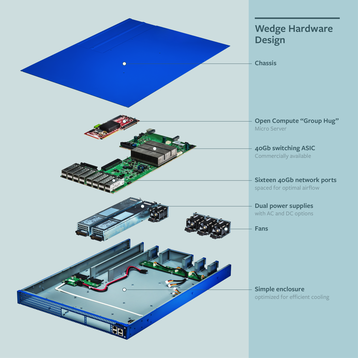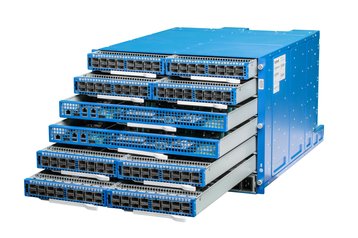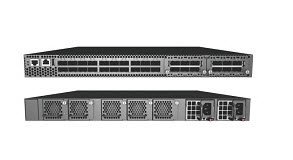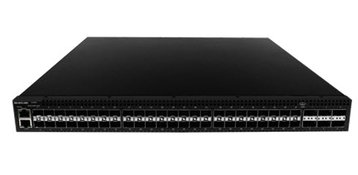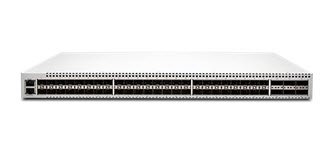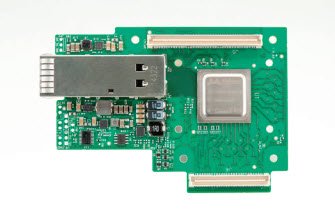Update: This article appeared in 2015. Since then, new switches have appeared, including Facebook’s Wedge 100, a 100GBE switch that updates the Wedge described here. Watch for a new DCD feature describing the developments.
Love it or hate it, the Open Compute Project (OCP) has been making waves in the data center hardware world. And when Facebook decided to make its own high performance data center switches, it put network giants like Cisco and HP on notice; times they are a changing.
It’s been two years since Facebook announced the goal of developing an OS-agnostic top-of-rack switch for data centers, which would be shared through the OCP. And it’s been a year since the actual arrival of the TOR switch codenamed Wedge along with a Linux-based OS to run it, code named FBOSS.
Shared architecture
The Wedge TOR uses the same modular micro-server architecture that Facebook was already deploying for the standard OCP server in its data centers. This means Wedge switches can slide seamlessly into Facebook’s existing software deployment, provisioning, and management system.
But just because something works for Facebook doesn’t mean it will work for everyone, and there are other open switches in the OCP ecosystem.
A selection of vendors, including Accton, Broadcom, Intel, and Mellanox, have also provided reference designs that were accepted as open switches by the OCP.
On the software side, Big Switch Networks contributed Open Network Linux to the OCP design (formally accepted in March 2015), and Cumulus Networks offered the Open Network Install Environment (ONIE) and ACPI Platform Description (APD) technology to simplify the development of software for these swtiches.
The basic idea of ONIE and ADP is to enable a bare metal network switch environment. ADP allows the creation of BIOS accessible information that can be accessed by the operating system to dynamically generate all of the necessary control interfaces. ONIE defines the installation environment that combines a boot loader with the Linux kernel and Busybox and provides the environment for the Installation of the compatible OS of choice. Because it is Linux-based it allows the switches to be managed, provisioned, and deployed in the same way that users currently manage Linux server hardware
Broadcom also submitted a specification, currently in the final stages of approval, called the OCP Open Switch, based on the existing StrataXGS Trident switch technology. The key features of the specification, presented in conjunction with Interface Masters, are
- Open rack and enterprise rack 1U-compliant leaf and spine switch design
- Leaf switch configurations: 48x10GbE + 6x40GbE ports or 48x10GbE + 12x40GbE ports
- Spine switch configurations: 32x 40GbE ports or 96x10GbE + 8x40GbE ports
- Supports ONIE and multiple off-the-shelf network OS options
- X86 control plane CPU with server-class Linux operating system and tools
- Available options for other MIPS/PPC CPUs
- Support for optional data plane co-processor based on Broadcom XLP432 for L4-L7 network functions acceleration
Here comes reality
Fast forward a year and in 2015, what were white papers and reference designs have become actual products in the marketplace. Facebook has gone from focusing on just TOR switches to building a switch capable of replacing spine and leaf switches within the data center, using the same basic technology as the Wedge TOR switch. Facebook calls this open modular switch platform “6-pack”. Full details on the device, introduced in February, can be found here.
What were white papers and reference designs have become actual products
Additional software specifications have appeared, as well, with Big Switch Networks, Dell, Mellanox and Microsoft submitting their Switch Abstraction Interface (SAI) to the OCP. SAI is complementary to ONIE, with SAI abstracting the FPGA switch silicon to allow developers to write to a single specification instead of needing to tweak the code for different brands of silicon.
In March 2015, a design specification was accepted by OCP for next generation 100 GbE switches and a cost-optimized 40 GbE design jointly submitted by Accton Technology Corp and Edge-Core Networks.
But what can you buy?
Designs and specifications mean little if the IT department can’t go out and purchase a product. And while a look at the OCP Networking Specs and Designs page shows only two accepted hardware products, both from Accton, drilling down a little deeper will show that other vendors have hardware built to more recent versions of the design specification, which are already in production.
There are also devices that are not part of the specification process but are simply being built to the model. These are being submitted to certification at the University of Texas San Antonio OCP Certification and Solution Laboratory. Though there has been some controversy about the facility and its procedures, vendors are selling equipment that has been certified by the facility as OCP compliant.
Edge-Core Networks, for example, has four certified networking products tested by the lab for compliance. In March 2015, Edge-Core was also the first vendor to release a commercial product based directly on Facebook’s TOR design, the Wedge-16X, which is being manufactured by Accton. With the Wedge modular design also being the core concept for Facebook’s 6-Pack leaf and spine switch it is a reasonable presumption that Edge-Core will continue down this path of development, if the company determines that there is sufficient demand for the product.
Even unexpected vendors have joined up with the OCP networking group. At the beginning of the year Juniper networks began shipping the OCX11000 switch based on the OCP design, running the Junos operating system, and built in partnership with Alpha Networks, one of the early adopters of the OCP networking spec.
Networking giant HP has accepted the reality of OCP networking and is working with their longtime partner Accton to bring HP-branded OCP compliant switch products to the market. Both Accton and Alpha Networks already have OCP compliant switch hardware available for purchase, as do Mellanox and Inventec. Edge-Core Networks has introduced a line of bare metal switches that come preloaded with ONIE to allow the customer to load the compatible switching operating system of their choice. Original design manufacturers, such as Quanta and ODM are also building OCP compliant hardware for unnamed customers.
While the OCP standard has a lot of flexibility and can fit in as a solution for a significant number of data center situations, it is not suitable for all environments. Few companies have the same type of data center needs as a Facebook or Google. Most data centers don’t have huge numbers of servers performing the same tasks, but are still suitable for the deployment of OCP compliant switching.
Cloud support, Hybrid SDN networking, CDNs all seem to be a good match for OCP hardware. Where it doesn’t yet fit is in environments that require significant fault tolerance. There is a reason that certified fault tolerant hardware is expensive and very specific in terms of what software and operating systems are supported. The cost of building and guaranteeing the level of availability demanded by users with these requirements is at odds with the basic premise of OCP, where the hardware architecture is a commodity item.

